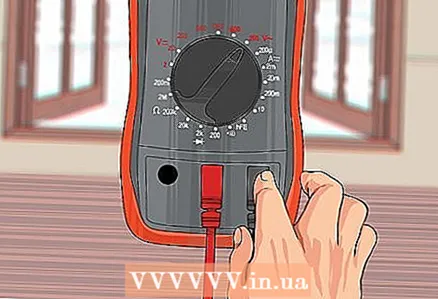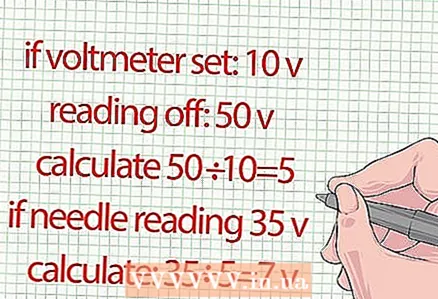Author:
Marcus Baldwin
Date Of Creation:
19 June 2021
Update Date:
1 July 2024

Content
- Steps
- Part 1 of 3: Setting Up the Instrument
- Part 2 of 3: Measuring Voltage
- Part 3 of 3: Reading Analog Voltmeter Readings
- Tips
- Caveats
A voltmeter is one of the most useful tools for performing electrical checks at home when used correctly. Before using the voltmeter for the first time, learn how to use the meter properly and test it on a low voltage circuit such as a household battery.
This article describes how to check voltage. You may also be interested in using a multimeter to check current and resistance.
Steps
Part 1 of 3: Setting Up the Instrument
 1 Setting up the device for measuring voltage. Most voltage measuring instruments are actually "multimeters" that allow you to check several parameters of electrical current. If your instrument has a switch with multiple settings, set the following:
1 Setting up the device for measuring voltage. Most voltage measuring instruments are actually "multimeters" that allow you to check several parameters of electrical current. If your instrument has a switch with multiple settings, set the following: - To check the AC line voltage, set the switch to V ~, ACV or VAC... Household electrical circuits are almost always alternating current.
- To check the DC line voltage, select V–, V ---, DCV or VDC... Batteries and portable electronic devices are usually DC powered.
 2 Select a range higher than the maximum expected voltage. Most voltmeters provide several options, you can change the sensitivity of the meter to get accurate measurements and avoid damage to the device. If your digital device does not allow you to select a range, then it is selected automatically - the device will determine the correct range by itself. Otherwise, follow the instructions:
2 Select a range higher than the maximum expected voltage. Most voltmeters provide several options, you can change the sensitivity of the meter to get accurate measurements and avoid damage to the device. If your digital device does not allow you to select a range, then it is selected automatically - the device will determine the correct range by itself. Otherwise, follow the instructions: - Select a setting "above" the maximum expected voltage. If you have no idea what values to expect, select the highest available option to avoid damaging the instrument.
- Household batteries usually have a specified voltage, usually 9V or less.
- Car batteries give approximately 12.6V when fully charged and the engine is turned off.
- Household outlets typically provide 240 volts in most parts of the world and 120 volts in the United States and some other countries.
- mV means millivolt (/1000 V), sometimes this unit of measurement means the minimum value in the device settings.
 3 Insert the test leads. The voltmeter must be equipped with one black and one red probe. Each end has a metal probe, and the other end of the probe has a metal connector that fits into a hole on the voltmeter. Connect the test leads to the connectors as follows:
3 Insert the test leads. The voltmeter must be equipped with one black and one red probe. Each end has a metal probe, and the other end of the probe has a metal connector that fits into a hole on the voltmeter. Connect the test leads to the connectors as follows: - The black jack usually connects to the hole marked "COM."
- When measuring voltage, plug the red jack into the hole marked V (among other symbols). If there is no V mark, select the hole with the minimum number, or mark mA.
Part 2 of 3: Measuring Voltage
 1 Hold the test leads safely. Do not touch metal probes when connecting them to the circuit. If the insulation looks frayed or frayed, wear insulating gloves or purchase replacement parts.
1 Hold the test leads safely. Do not touch metal probes when connecting them to the circuit. If the insulation looks frayed or frayed, wear insulating gloves or purchase replacement parts. - The two metal probes must never touch when measuring voltage, otherwise spark and short circuit may occur.
 2 Attach the black test lead to one part of the current conductor. Measure voltage by applying test leads in parallel. In other words, you apply probes to two points in a closed circuit and current flows between them.
2 Attach the black test lead to one part of the current conductor. Measure voltage by applying test leads in parallel. In other words, you apply probes to two points in a closed circuit and current flows between them. - In the case of batteries, attach the black test lead to the negative pole.
- When measuring voltage at an outlet, attach the black test lead to the "neutral" hole, in the US this is the larger vertical hole or the vertical hole on the left side.
- Whenever possible, release the black dipstick before moving on. Many black test leads have a small plastic piece that allows the test lead to be secured to the outlet.
 3 Touch the red test probe to another point on the contour. This will close the parallel circuit and cause the meter to display voltage.
3 Touch the red test probe to another point on the contour. This will close the parallel circuit and cause the meter to display voltage. - In the case of a battery, touch the positive pole with the red test lead.
- While measuring the voltage at the outlet, insert the red test lead into the phase hole - in the USA, this is the smallest vertical hole or the vertical hole on the right side.
 4 Raise the allowed range if you receive an overload message. Immediately raise the allowed range on the voltmeter before your meter is damaged if you get any of the following results:
4 Raise the allowed range if you receive an overload message. Immediately raise the allowed range on the voltmeter before your meter is damaged if you get any of the following results: - The digital display shows "OL", "overload" or "1". Please note that "1V" is a real indicator, at which there is nothing to worry about.
- On an analog voltmeter, the needle jumps to the other end of the scale.
 5 Adjust the voltmeter if necessary. You may need to adjust the DVM settings if the display shows 0V or nothing at all, or if the needle barely moves on the analog voltmeter. If there are still no indicators, try the following in order:
5 Adjust the voltmeter if necessary. You may need to adjust the DVM settings if the display shows 0V or nothing at all, or if the needle barely moves on the analog voltmeter. If there are still no indicators, try the following in order: - Make sure both styli are touching the contour.
- If you are measuring DC voltage and you are not getting a result, look for the small lever or switch on the meter labeled DC + and DC- and move it to a different position. If your device does not have this option, swap the positions of the black and red probe.
- Decrease the range by one unit. Repeat as needed until you get a reading from the meter.
 6 Read the voltmeter readings. Digital voltmeters clearly show the voltage on an electronic screen. Analog voltmeters are a little more complicated to work with, but not overly complicated once you figure out the readings. Continue reading for instructions.
6 Read the voltmeter readings. Digital voltmeters clearly show the voltage on an electronic screen. Analog voltmeters are a little more complicated to work with, but not overly complicated once you figure out the readings. Continue reading for instructions.
Part 3 of 3: Reading Analog Voltmeter Readings
 1 Find the voltage scale at the end of the arrow. Select the indicator that you selected when setting up the voltmeter. If there is no exact match, calculate the indicator on the scale.
1 Find the voltage scale at the end of the arrow. Select the indicator that you selected when setting up the voltmeter. If there is no exact match, calculate the indicator on the scale. - For example, if the voltmeter is set to DC 10V, look on the DC scale for a maximum value of 10. If not, find the one with a maximum value of 50.
 2 Calculate the estimated position of the arrow based on the adjacent numbers. It is a linear scale, like a ruler.
2 Calculate the estimated position of the arrow based on the adjacent numbers. It is a linear scale, like a ruler. - For example, the arrow points to the middle of the segment between 30 and 40, which means that the voltage is 35V.
 3 Divide the result if you use a different scale. Skip this step if you are reading from a scale that exactly matches the voltmeter setting. Otherwise, make the correction by dividing the maximum value indicated on the scale by the setting of your voltmeter. Divide the number indicated by the arrow by your answer to find out the actual voltage.
3 Divide the result if you use a different scale. Skip this step if you are reading from a scale that exactly matches the voltmeter setting. Otherwise, make the correction by dividing the maximum value indicated on the scale by the setting of your voltmeter. Divide the number indicated by the arrow by your answer to find out the actual voltage. - For example, if the voltmeter is set to 10V, but you read the readings from the 50V scale, count: 50? 10 = 5... If the arrow points to 35V, the actual voltage will be: 35? 5 = 7V.
Tips
- The instructions for checking the voltage at the outlet assume that you are trying to determine the voltage that the devices plugged into the outlet "see". If you are trying to pinpoint wiring problems, you may need to know the voltage between ground and another hole.If you get a negligible voltage (eg 2V), this is the neutral ("zero") hole. If you are getting a significant voltage (like 120V or 240V) this is the phase hole.
Caveats
- Improper use can damage the device, result in electric shock or sparks that could start a fire. This is more likely to happen when testing high voltage outlets or circuits than when testing low voltage batteries.



